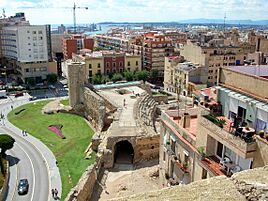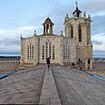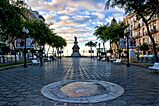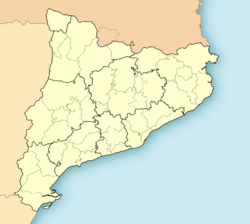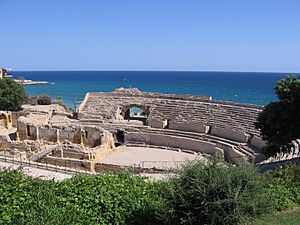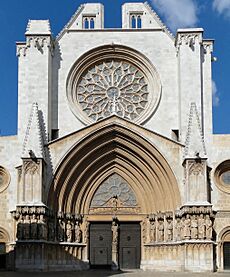Tarragona facts for kids
Quick facts for kids
Tarragona
|
|||
|---|---|---|---|
|
Municipality
|
|||
|
|
|||
|
|||

Location in Tarragonès county
|
|||
| Sovereign state | |||
| Community | |||
| Region | Camp de Tarragona | ||
| County | Tarragonès | ||
| Province | Tarragona | ||
| Founded | 5th century BC | ||
| Area | |||
| • Total | 57.9 km2 (22.4 sq mi) | ||
| Elevation
(AMSL)
|
68 m (223 ft) | ||
| Population
(2021)
|
|||
| • Total | 141,542 | ||
| • Density | 2,444.6/km2 (6,331/sq mi) | ||
| Postal code |
43001–43008
|
||
| Area code(s) | +34 (E) + 977 (T) | ||
| Climate | Csa | ||
Tarragona is a city and municipality located on the coast of Catalonia, Spain. It is the capital of the Tarragonès county and the Province of Tarragona. The city sits on the Costa Daurada (Golden Coast) by the Mediterranean Sea.
In the time of the Roman Empire, Tarragona was one of the most important cities on the Iberian Peninsula. It was even the capital of Roman provinces like Hispania Citerior and Hispania Tarraconensis.
Today, the Archaeological Complex of Tàrraco in Tarragona is a special place. It is recognized as a UNESCO World Heritage Site because of its amazing Roman ruins.
Contents
History of Tarragona
Early Beginnings
No one knows exactly when Tarragona was founded. Some old legends say it was named after a son of Tubal, or even an Ethiopian pharaoh.
The city might have started as an Iberian settlement called Kesse or Kosse. This name came from the local Iberian tribe, the Cossetans. Some historians think the Phoenicians, who were ancient traders, might have founded the city. They may have called it Tarchon, which means "citadel," because it was built on a high rock near the sea.
Tarragona is located on the Francolí River, close to the Mediterranean Sea. It was an important spot between the Pyrenees mountains and the Ebro River.
Tarragona in Roman Times
Tarragona was on a major road along the northeastern coast of Spain. During the Roman Republic, the city grew a lot. The Roman brothers Publius Cornelius Scipio and Gnaeus Cornelius Scipio Calvus made it a strong fortress. They used it as a base against the Carthaginians.
The city was first called Colonia Iulia Urbs Triumphalis Tarraco. It became the capital of the Roman province of Hispania Citerior. Later, it was the capital of the province named after it, Hispania Tarraconensis.
The Roman Emperor Augustus spent a winter in Tarragona. He gave the city many honors, including the titles Colonia Victrix Togata and Colonia Julia Victrix Tarraconensis.
Tarragona was known as a very rich city on the coast. Its fertile land and sunny shores were famous. The area produced good wine and flax. The city even made its own coins.
An important stone base for a statue was found in Tarragona. It described the career of Tiberius Claudius Candidus. He was a Roman governor and senator who helped Emperor Septimius Severus. This stone is now in the British Museum.
From Roman Decline to Spanish Union
After the Western Roman Empire fell, the Vandals and then the Visigoths took over Tarragona. The Umayyad conquest of Hispania in 714 ended Visigothic rule.
Tarragona was an important border city for the Caliphate of Córdoba for many years. Later, it was part of the Taifa of Zaragoza and then controlled by the Almoravid dynasty.
In 1117, the County of Barcelona took control of Tarragona. From 1129 to 1173, it was the capital of a short-lived area called the Principality of Tarragona. This area had some Norman influence.
After the Aragon and Barcelona joined, Tarragona became part of the Principality of Catalonia. This was within the Crown of Aragon until 1714. When Aragon and the Crown of Castile joined, it remained part of the Crown of Aragon. This lasted until the Spanish Empire was formed in 1516.
During the Reapers' War, Tarragona was captured by Catalan rebels with French help in 1641. But Spanish troops took it back in 1644. In 1705, during the War of the Spanish Succession, allied troops from Portugal, the Netherlands, and Britain captured it. They held it until 1713. After this war, the Nueva Planta decrees were signed. These laws ended the Crown of Aragon and Catalan institutions. They also made it harder to use the Catalan language.
Jewish Community in Tarragona
The Jewish community in Tarragona was very old, starting during Roman times. A special basin, possibly used for ritual purification, was found with a Hebrew inscription. Coins with Hebrew writing from the Visigoth period have also been found.
During Muslim rule, Jewish people in Tarragona did well. Some even called Tarragona "the city of the Jews." However, after the Christian reconquest, Jewish people faced challenges. The community was eventually destroyed in 1492 during the expulsion of the Jews from Spain.
Peninsular War Conflicts
During the Peninsular War, Tarragona faced two sieges. In the first siege in 1811, the French army attacked the city. A British navy squadron helped the Spanish defenders. But the French troops eventually took the city. They captured or killed almost all the defenders.
In the second siege in 1813, a large British and Spanish force tried to take Tarragona back. But a small French and Italian group held the city. The British commander was later removed for his poor leadership. The British and Spanish forces finally captured Tarragona on August 19.
Spanish Civil War
During the Spanish Civil War, Tarragona was controlled by the Second Spanish Republic. But on January 15, 1939, Franco's Nationalist troops captured the city. This happened during the Catalonia Offensive.
Main Sights in Tarragona
The Roman ruins of Tarraco are a World Heritage Site recognized by UNESCO.
Ancient Roman Remains
- Some parts of very old walls near the Cuartel de Pilatos might be even older than the Romans.
- The Tarragona Amphitheatre is near the sea. It was used a lot for building materials after the Roman Empire fell. So, only a few parts of it are left today.
- A Roman circus, about 450 m (1,480 ft) long, was built over. But you can still see parts of it in the area called Plaça de la Font.
- You can find Latin and even Phoenician writings on stones in the city's old buildings.
Two ancient monuments outside the city are still in good condition:
- The Les Ferreres Aqueduct: This Roman aqueduct crosses a valley about 4 kilometres (2 miles) north of the city. It is 217 m (712 ft) long. Its tallest arches are 26 m (85 ft) high.
- The "Tower of the Scipios": This monument is about 6 km (4 mi) east of the city on the coast road. No one knows for sure if the Scipios were buried here.
Other Roman buildings you can see include:
- The Roman walls
- The Amphitheatre
- The Roman circus
- The Pretorium – Tower
- The Provincial and Colonial fora
- The Necropolis (an ancient cemetery)
- The Arch of Sura, or of Bara
- The Aurelian Way (an ancient Roman road)
The city also has the National Archaeological Museum of Tarragona. Here you can learn more about Tarragona's ancient past.
Religious Buildings
- The Tarragona Cathedral: This large church was built between the 12th and 13th centuries. It mixes Romanesque and Gothic styles.
- The archiepiscopal palace: This building is on the site of the old Roman capitol. One of its towers is still standing.
- Near the sea, in the Roman amphitheater, you can find the remains of a church called Santa Maria del Miracle. This church once belonged to the Knights Templar.
Modern Tarragona Life
Tarragona has one of the biggest ports in Spain. It is a major place for exporting cars made in Spain. Many chemical industries are also located west of the city, which helps the economy.
The city is home to the Rovira i Virgili University. This is an important place for education.
Tarragona is famous for its "Popular Retinue." This is a big parade with dances, animal figures, and spoken performances. It also features the building of human towers called castells. These traditions are very popular during the Santa Tecla Festival. You can learn about them all year at the "Casa de la Festa" (Festivities House).
Many beautiful beaches with a Blue Flag award are along the Mediterranean coast near the city.
Tarragona is close to the resort town of Salou. It is also near PortAventura World. This includes PortAventura Park, which is the most visited theme park in Spain. There is also Ferrari Land and the PortAventura Caribe Aquatic Park.
The city is served by the Camp de Tarragona high-speed railway station. Reus Airport is also just a few kilometers away. This airport offers many low-cost flights.
Reus is another important city in the Tarragona area. It is known for its shops and for being the birthplace of the famous architect Antoni Gaudí.
Tarragona hosted the 2018 Mediterranean Games. This was a big international sports event.
Tourism in Tarragona
Tarragona is part of the World Heritage Journeys in the European Union. Many visitors come to see its main attractions:
- Mercat Central de Tarragona (Central Market)
- La Rambla Nova (the main shopping street)
- El Serrallo fishing village
- The beautiful beaches of the golden coast
- The main plazas (Plaça de la Font, Plaça del Fòrum, Plaça del Rei)
- Balcó del Mediterrani (Mediterranean Balcony)
- Praetorium and Roman Circus
- Roman Amphitheatre
- Model of Roman Tarraco
- The Tarragona Cathedral
The GR 92 long-distance walking path goes through Tarragona. This path follows the Mediterranean coast of Spain.
Food and Drink
Tarragona has many small bars, restaurants, and cafes. They serve tapas (small dishes) and sandwiches. You can also try local seafood and Catalan dishes. Some popular ones are "pa amb tomàquet" (bread with tomato) and "neules i torrons" (traditional sweets).
Many of these places are in the historic center, like at Plaça de la Font. The El Serrallo neighborhood, by the harbor, is known for its delicious seafood.
Chartreuse liqueur is a famous local drink. It was first made in 1605 by monks. They believed it was an "elixir for long life." It comes in yellow (40% alcohol) and green (55% alcohol). For many years, Chartreuse was distilled in Tarragona. Today, Chartreuse is an important part of the Feast of Santa Tecla. This festival celebrates the city's patron saint.
Tarragona's Climate
Tarragona has a Mediterranean climate. This means it has mild, cool winters and warm, humid summers. The wettest times of the year are spring and autumn. They get about 54 to 77 mm (2.1 to 3.0 in) of rain in May and September.
| Climate data for Reus Airport (1981–2010) (between Reus – 3 km (1.86 mi) and Tarragona – 7 km (4.35 mi)) | |||||||||||||
|---|---|---|---|---|---|---|---|---|---|---|---|---|---|
| Month | Jan | Feb | Mar | Apr | May | Jun | Jul | Aug | Sep | Oct | Nov | Dec | Year |
| Record high °C (°F) | 24.2 (75.6) |
25.0 (77.0) |
27.7 (81.9) |
30.2 (86.4) |
32.8 (91.0) |
36.8 (98.2) |
37.4 (99.3) |
38.0 (100.4) |
33.8 (92.8) |
32.5 (90.5) |
28.8 (83.8) |
22.6 (72.7) |
38.0 (100.4) |
| Mean daily maximum °C (°F) | 14.1 (57.4) |
14.9 (58.8) |
17.1 (62.8) |
19.0 (66.2) |
22.2 (72.0) |
26.3 (79.3) |
29.3 (84.7) |
29.4 (84.9) |
26.3 (79.3) |
22.3 (72.1) |
17.5 (63.5) |
14.6 (58.3) |
21.1 (70.0) |
| Daily mean °C (°F) | 9.0 (48.2) |
9.7 (49.5) |
11.9 (53.4) |
13.8 (56.8) |
17.2 (63.0) |
21.2 (70.2) |
24.2 (75.6) |
24.6 (76.3) |
21.5 (70.7) |
17.5 (63.5) |
12.6 (54.7) |
9.7 (49.5) |
16.1 (61.0) |
| Mean daily minimum °C (°F) | 3.9 (39.0) |
4.5 (40.1) |
6.6 (43.9) |
8.6 (47.5) |
12.1 (53.8) |
16.1 (61.0) |
19.1 (66.4) |
19.7 (67.5) |
16.6 (61.9) |
12.7 (54.9) |
7.6 (45.7) |
4.7 (40.5) |
11.1 (52.0) |
| Record low °C (°F) | −7.6 (18.3) |
−8.0 (17.6) |
−5.4 (22.3) |
1.0 (33.8) |
3.6 (38.5) |
7.4 (45.3) |
10.5 (50.9) |
10.8 (51.4) |
5.5 (41.9) |
0.2 (32.4) |
−4.0 (24.8) |
−7.5 (18.5) |
−8.0 (17.6) |
| Average precipitation mm (inches) | 29 (1.1) |
28 (1.1) |
28 (1.1) |
37 (1.5) |
54 (2.1) |
25 (1.0) |
15 (0.6) |
42 (1.7) |
77 (3.0) |
75 (3.0) |
53 (2.1) |
36 (1.4) |
500 (19.7) |
| Average precipitation days (≥ 1 mm) | 4 | 4 | 4 | 5 | 5 | 3 | 2 | 4 | 5 | 6 | 4 | 4 | 50 |
| Mean monthly sunshine hours | 157 | 162 | 197 | 222 | 251 | 274 | 306 | 265 | 209 | 182 | 157 | 145 | 2,527 |
| Source: Agencia Estatal de Meteorología | |||||||||||||
| Climate data for Vila-seca (1971–2000) (14 km (8.70 mi) south-west of Tarragona | |||||||||||||
|---|---|---|---|---|---|---|---|---|---|---|---|---|---|
| Month | Jan | Feb | Mar | Apr | May | Jun | Jul | Aug | Sep | Oct | Nov | Dec | Year |
| Record high °C (°F) | 20.8 (69.4) |
24.0 (75.2) |
28.2 (82.8) |
29.1 (84.4) |
30.6 (87.1) |
31.3 (88.3) |
34.5 (94.1) |
35.2 (95.4) |
33.3 (91.9) |
30.7 (87.3) |
25.5 (77.9) |
25.0 (77.0) |
35.2 (95.4) |
| Mean daily maximum °C (°F) | 12.4 (54.3) |
15.2 (59.4) |
17.8 (64.0) |
19.5 (67.1) |
22.1 (71.8) |
25.6 (78.1) |
29.3 (84.7) |
30.2 (86.4) |
27.6 (81.7) |
22.4 (72.3) |
16.4 (61.5) |
12.7 (54.9) |
21.0 (69.8) |
| Daily mean °C (°F) | 10.0 (50.0) |
11.9 (53.4) |
14.1 (57.4) |
15.9 (60.6) |
18.8 (65.8) |
22.5 (72.5) |
25.9 (78.6) |
26.7 (80.1) |
24.0 (75.2) |
19.1 (66.4) |
13.9 (57.0) |
10.7 (51.3) |
17.8 (64.0) |
| Mean daily minimum °C (°F) | 7.5 (45.5) |
8.7 (47.7) |
10.4 (50.7) |
12.2 (54.0) |
15.5 (59.9) |
19.4 (66.9) |
22.5 (72.5) |
23.2 (73.8) |
20.3 (68.5) |
15.8 (60.4) |
11.3 (52.3) |
8.7 (47.7) |
14.7 (58.5) |
| Record low °C (°F) | −1.6 (29.1) |
−1.0 (30.2) |
0.6 (33.1) |
4.5 (40.1) |
9.0 (48.2) |
12.6 (54.7) |
16.0 (60.8) |
14.3 (57.7) |
13.0 (55.4) |
7.3 (45.1) |
2.7 (36.9) |
−1.0 (30.2) |
−1.6 (29.1) |
| Average precipitation mm (inches) | 37.2 (1.46) |
19.1 (0.75) |
36.6 (1.44) |
38.2 (1.50) |
53.2 (2.09) |
33.3 (1.31) |
15.7 (0.62) |
52.8 (2.08) |
68.2 (2.69) |
63.7 (2.51) |
46.9 (1.85) |
44.7 (1.76) |
509.0 (20.04) |
| Average precipitation days (≥ 1 mm) | 5.0 | 3.5 | 4.8 | 5.8 | 6.1 | 3.9 | 2.7 | 4.3 | 4.8 | 5.8 | 5.0 | 5.1 | 56.8 |
| Source: Servei Meteorològic de Catalunya | |||||||||||||
Events and Festivals
Tarragona hosts many exciting events throughout the year:
- The Carnival: A lively celebration with parades and costumes.
- Tarragona International Dixieland Festival: This festival features many bands and concerts before Holy Week.
- Tarraco Viva: An international festival about Roman history. It includes music, exhibitions, workshops, and talks.
- Tarragona International Fireworks Displays Competition: Six international companies compete with amazing fireworks shows. Official website1: http://www.tarragona.feuerwerk.net
- Sant Magí Festival: Held every year between August 15 and 19.
- Santa Tecla Festival: This is a very important festival, celebrated from September 15 to 24. It has been happening since 1321 and is a major tourist attraction.
- Tarragona 2018 XVIII Mediterranean Games: A big international sports event held in Tarragona in 2018.
Tarragona's Sister Cities
Tarragona has special connections with other cities around the world. These are called "twin towns" or "sister cities."
|
Tarragona also had partnerships with:
Images for kids
See also
 In Spanish: Tarragona para niños
In Spanish: Tarragona para niños


